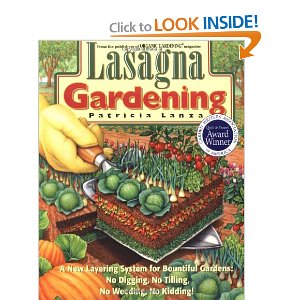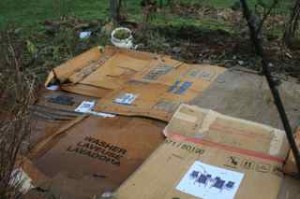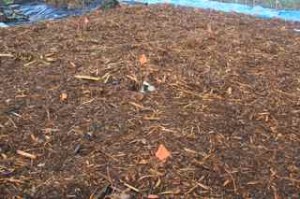
Lasagna Gardening: A New Layering System for Bountiful Gardens: No Digging, No Tilling, No Weeding, No Kidding!
Seems like everyone has already read this book – except me. I put off reading / buying this book (I hate to admit this) because I figured I already “got it.” I mean, c’mon – “lasagna” is a perfect description for layers – and “lasagna gardening” immediately conjures visions of several good things layered on top of something relatively flat, the strata are repeated, and lots of garlic is infused throughout – so how can you go wrong?
But here’s the thing – Lanza’s method is more-or-less a more complicated version of the classic The Ruth Stout No-Work Garden Book, which simply involves heaping copious amounts of mulch on everything, and as much of a fan as I am of Ruth Stout, the whole layering and mulching thing isn’t for everyone. For example, my book on Growing Vegetables West of the Cascades: The Complete Guide to Organic Gardening
by Steve Solomon, the guy who started Territorial Seeds and definitely an authority on gardening in the Pacific Northwest, gives strong reasons NOT to mulch your garden, at least not in this neck of the woods. Mulch provides a cozy place for varmints, insects, and mollusks without shells, i.e., slugs, for which, the Northwest is famous. After losing 75% of my garlic crop to molds, I am a bit leery of mulches, despite the weed-suppressing, water-conserving benefits they may provide. Applying it, pulling it back, and applying it again repeatedly throughout the year isn’t all that practical when you’re talking about an acre.
So to continue my story, there I was browsing through the gardening books at our local library, and “Lasagna Gardening” jumped out at me, and I realized I had never read it. I had only heard lots about it. I only thought I knew what it all meant. Plus, I really liked the picture on the cover.
As it turns out, “Lasagna Gardening” offers some good ideas, and for beginner gardeners, all the basics are covered. As you might expect, the actual method is just a form of sheet composting – and at this point, you can find a lot of info on these methods on the Internet. Whether the repeated layers are really necessary is up for debate, although as a means of getting things mixed up without having to turn things over, I am sure it helps jumpstart microbial action. Still, the lasagna layers advocated by Lanza seem a bit extreme to me: newspaper, peat moss, barn litter, peat moss, compost, peat moss, grass clippings, peat moss, chopped leaves, peat moss, wood ashes – good grief! How many of us can pull this off? Course, this is just an example – and the exact material you use will depend on what you have, obviously. But good grief, the repeated use of peat is just appalling to me! Sure, peat holds 10 to 20 times its weight in water – BUT – and this is a BIG but – peat is derived from very slow growing plants that rot very slowly. By some accounts, it takes 1000 years to make a 1-yard depth of peat. Peat is a nonrenewable resource. Of course, if you go to the Canadian Sphagnum Peat Moss Association website, you will get quite a different story. The truth? I don’t know. For me, I can’t advocate using it.
Despite the controversy, there is always something you can get out of a book – and the popularity of “Lasagna Gardening” is proof that it has been successful in helping people understand the importance and rewards of building good soil. (After all, you don’t HAVE to use peat – use whatever you have according to the needs of your garden.) You know you’ve hit it right when it takes on a life of its own. One of the more inspirational stories I’ve come across is what they’re doing on the University of Massachusetts campus. They have taken about ¼ acre of lawn and, using the “lasagna method,” have layered on top of it about 200,000 pounds of organic matter in the form of compost, cardboard, and mulch. Planting starts this spring on what will supply the UMass dining hall with fresh food. Students are getting hands-on experience in what it means to grow food – to connect with the soil that feeds you – and also gaining an awareness of the consequences of relying on large agribusiness for your food supply. See their video:
UMass Permaculture Documentary Series (Part 1/3)
Cool, huh?
Personally, I liked this book because it was one of several that inspired me to quit slaving over ridding my garden of weeds and just cover them up and move on.


I embarked on a serious mission. I am laying down massive quantities of cardboard and topping it with a local supply of shredded bark and woodchips – because that is what is accessible to me, being as I ordered a flatbed-sized load of it and it is like a steaming mountain in my backyard that – I kid you not – it dwarfs my VW bus (1972, in case you’re curious). Oh yeah, I don’t do things half-way. I am going to smother this freaking quack grass once and for all – I am just getting too old to deal with this **** anymore. Yes, I am over the edge. I so hate grass, you can’t believe it. And don’t even get me started on Morning Glory.
I am in direct competition with close friends for the cardboard stash behind the local Sears outlet – and I am sure they will read this and know I am scoping out the delivery schedule. I may even set my alarm. After I cover the garden, I will expand to the orchard – and there is simply no stopping. I would steal the newspapers out of local collection bins, but I would feel like I was stealing from the Boy Scouts – and who in their right conscience can do that? So cardboard and junk mail it is. It is pouring down rain out there right now and the winds are predicted to slam us at gale forces topping 40 knots. Bring it on, I say. I’ll be out there.
But when it comes to the tender plants I care for and adore, I am using a slightly different strategy. As Lasagna Gardening suggests, I am adding a more nutrient-rich base that caters to the needs of individual plants. I try to be encouraging. When it comes to the garlic, though, it’s hands off. Bare ground is warming up nicely and they are responding to the longer daylight. The raised beds are draining off the excess spring rain. Foliar sprays are on my schedule, but no mulch.
But before I get further sidetracked on the garlic, I need to say that the book, “Lasagna Gardening” is about much more than just piling up layers of stuff to build soil in the garden. The whole layering discussion takes up a surprisingly small section of the book. The great majority of the book is about growing veggies, herbs, berries, flowers, and combination gardens, info on beneficial insects, gardening in different seasons, plants for birds and other wildlife, and more. For example, Lanza suggests trapping your slugs under roof shingles and zapping them with a spray bottle of half-n-half ammonia and water in the morning. That little tip alone was worth reading the book. “Yes, a pan of beer will attract slugs and they will die, but I hate to empty the pan of dead slugs. They are nasty when alive but dead they are truly repulsive.” I can so relate. This is coming from someone who has been known to squish slugs with her bare hands. (It’s quick if they’re small.) I confess to having a twinge of sympathy watching them shrivel under salt – so maybe having one last frat party in a bucket of stale beer is a more humane way to go, but I’ll have to try the ammonia idea.
I don’t know. Maybe the book should have been called something else. But you have to admit, “Lasagna Gardening” is pretty catchy.
My recommendation: Check out the book from your library. If it’s the reference you’ve been looking for, buy it. If not, look for those things you can take away. Whether you keep it- or read it, absorb it, and return it – you can always modify the methods to suit your needs.
Thank you, Patricia Lanza.